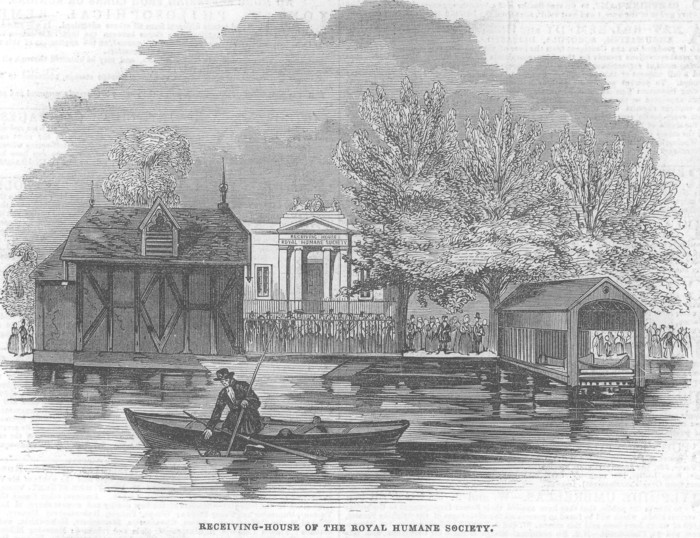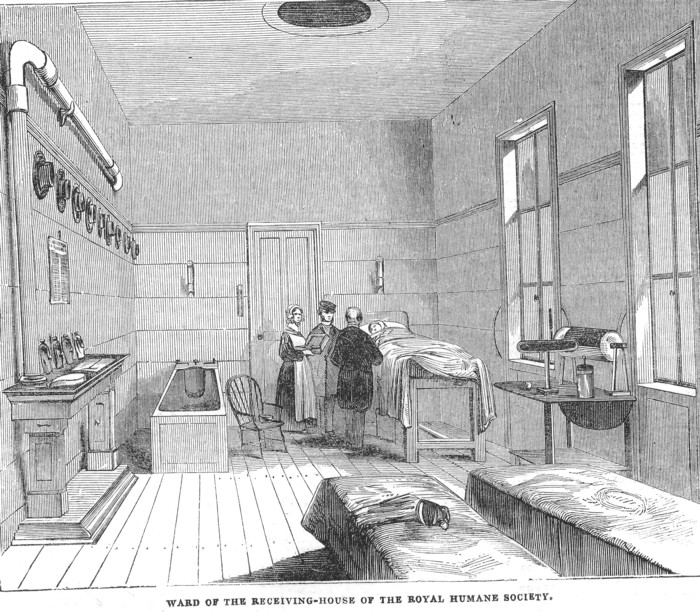There cannot be a more opportune period than the present bathing-season, for introducing to our readers the many advantages which have accrued to the public from the establishment of the Royal Humane Society, for the recovery of persons apparently drowned or dead.
The Institution was founded in 1774, by Drs. Goldsmith, Heberden, Towers, Lettsom, Hawes, and Cogan.; but principally by the exertions of the last three gentlemen. The Society offers rewards and medals, for saving lives. The number of cases in which successful exertions have been made, have amounted to several thousands; and the number of claimants rewarded—so long as nine years since—exceeded 20,000. Similar institutions have been established in other parts of Great Britain, in our colonies, and elsewhere.
The Society has eighteen receiving-houses in the metropolis. The principal house was erected in the year 1794, on the north bank of the Serpentine, in Hyde-park, upon a piece of ground presented to the institution by George III., and subsequently extended by William IV; the patron. The fitness of this site is attested by the number of persons resorting to the Serpentine in the bathing and skating seasons, and consequently the number of accidents occurring there. Indeed, it is stated that not less than 200,000 persons on an average annually bathe in the river and the neigbourhood of the receiving-house; and on one occasion, during a frost, twenty-five-individuals were submerged by the breaking of the ice; but, by the exertions of men (who are required to be good swimmers) employed by the Society at such seasons, and the proximity of the receiving-house, no life was lost.
The house built in 1794 was taken down in 1834, and the foundation-stone of the building shown in the engraving was laid by his Grace the Duke of Wellington. It is a neat structure, of fine brick fronted and finished with Bath and Portland stone. The front has pilasters at the angles and a neat entablature, which is surmounted by the royal arms upon a pedestal. Over the entrance is a pediment supported by two fluted Ionic columns and pilasters; upon the entablature is inscribed "Royal Humane Society's Receiving-House." The door-case is tastefully enriched; over it is sculptured in stone a fac-simile of the Society's medal?, encircled with a wreath; the design being a boy endeavouring to rekindle an almost extinct torch by blowing it, and the motto being " Lateat scintillvia forsans"—"Perchance a spark may be concealed."
The interior of the receiving-house consists of an entrance-hall, with a room for medical attendants on the left, and waiting-room on the right; parallel with which are two separate wards for the reception of male and female patients. Each contains beds warmed with hot water, a bath, and a hot-water, metal-topped table for heating flannels, bricks, &c.; the supply of water being by pipes around the walls and beneath the floor of the rooms. Next are a kitchen and two sleeping-rooms, for the residence of the superintendent and his family; adjoining is the furnace for heating water, planned by Messrs. Simpson and Thompson, engineers of the Chelsea Water-works. In the roof of the building are two cisterns for cold, and one for hot water. In the rear is a detached shed, in which are kept boats, ladders, ropes, and poles; wicker boats are likewise in constant readiness. In short, the whole of the arrangements are upon the most complete scale; the medical assistants of the Institution reside near the spot; and the superintendent supplies the furnace from daybreak till eleven o'clock at night; so that a hot water bath can be made ready for use in a minute. Lastly, the Committee consider this receiving-house a model for all other institutions of the same kind.
This unique building was erected from the design of J. B. Bunning, Esq., architect, who is a member of the Committee, and, upon this occasion, generously relinquished all claim on the Society for his professional services.
Proper attendants, warn baths, beds, and tables, apparatus, and copper, are in constant readiness during the bathing and skating seasons, to prevent the fatal or injurious effects of any accident. Our second engraving represents the interior of one of the wards; with the arrangement of the bath, the bed, table, the electrical machine, &c.
According to the last report of the Society, there had been, within one year, 164 claimants to rewards; to 23 of whom the silver medal had been awarded; to 15 the bronze medal; and pecuniary rewards bestowed on 126. Within this period, the lives of 171 persons had been preserved from casualties. The apparatus for the preservation and restoration of life is very complete; and the Society lost no opportunity of introducing improved methods. Among the latter are newly-invented circular bellows for inflation; Mr. Williams's floating drag, with a zinc buoy; and Mr. Pigot's inflated cravats. A Director of the Society has recently asserted that there is not an establishment in Europe more perfect, or in more efficient order, than the Receiving-house in Hyde-park; and the activity of its superintendents and boatmen is beat attested by the promptness with which, in three minutes, one of the latter, at the beginning of the present month, found a body, having, in the mean time, picked up another man who was drowning. A daily report of the estimated number of bathers is made to the Secretary; and, by careful and moderate computation, they have exceeded 270,000 during June and July of the present year. During this period thirty-one cases were rescued, and fifteen taken to the receiving-house, where they were successfully restored from apparent death; and; up to the 2nd instant, only three casualties had proved fatal since the bathing season had commenced. It should be added, that the Institution cannot exceed its present expenses; and the establishment in Hyde-park already costs a very large portion of the Society's income. "If we look at the crowded state of the river Thames, the wonderful increase of traffic by steam, and the numerous accidents—too many of which have been fatal—we shall find ample room for the employment of more men and boats by the Humane Society. There is, indeed, a fiine field for the Institution to carry out its objects, and cheerfully would the Committee endeavour to do as much on the Thames as it has done on the Serpentine, if the public whose safety alone is concerned, would enable it to do so."

Receiving House of the Royal Humane Society

Ward of the Receiving House of the Royal Humane Society